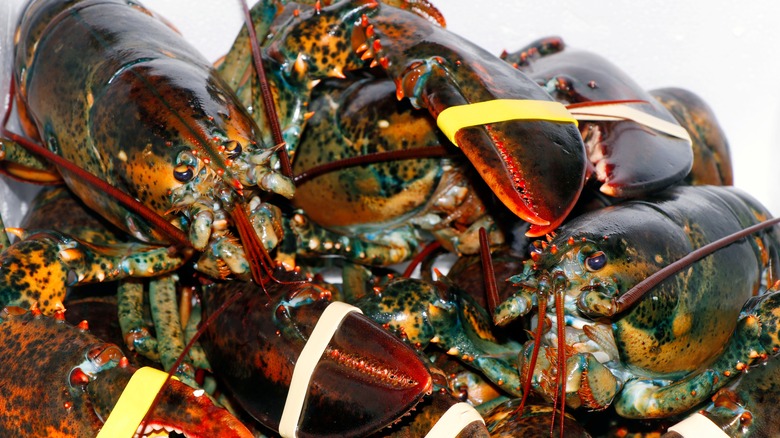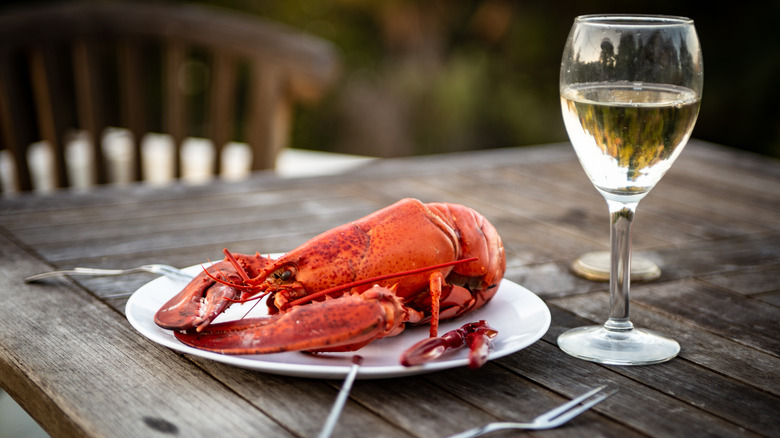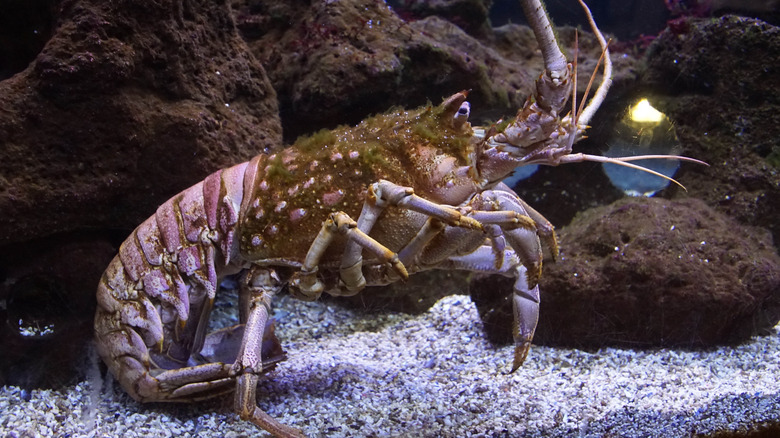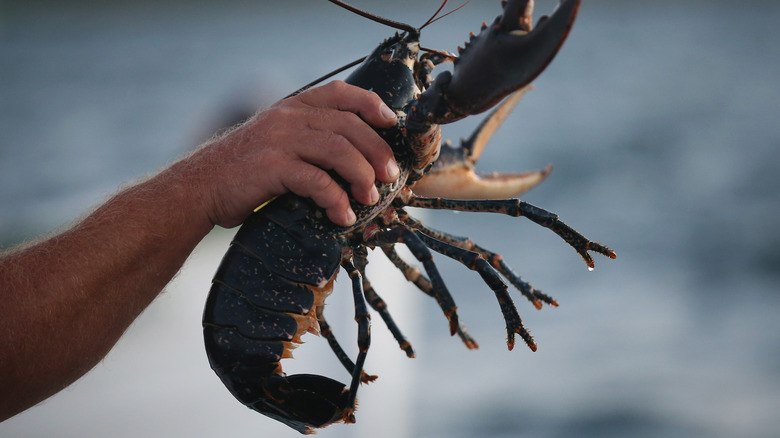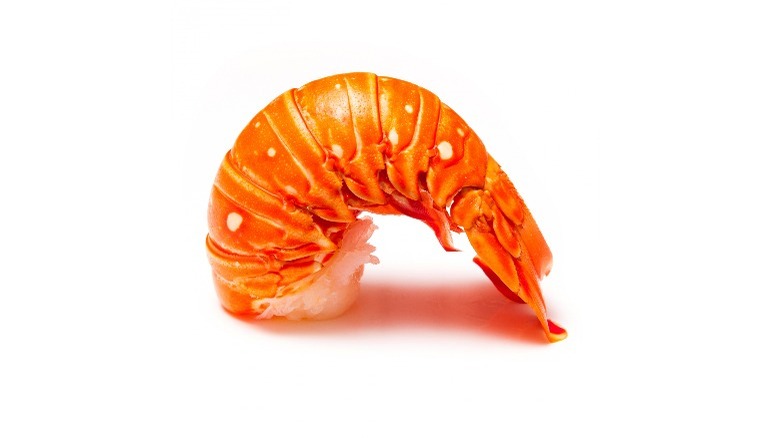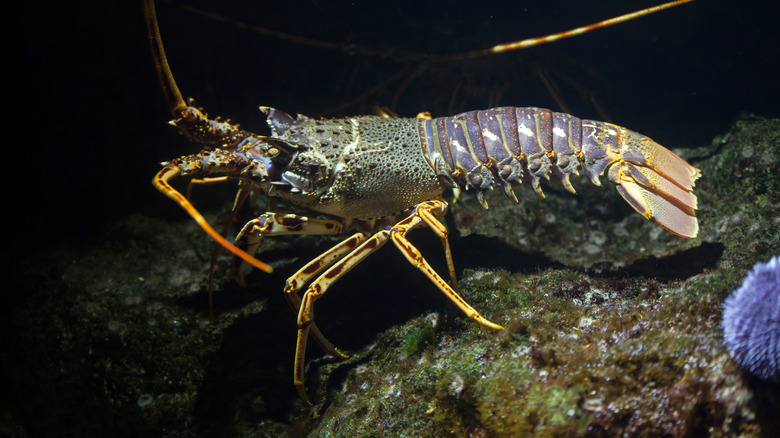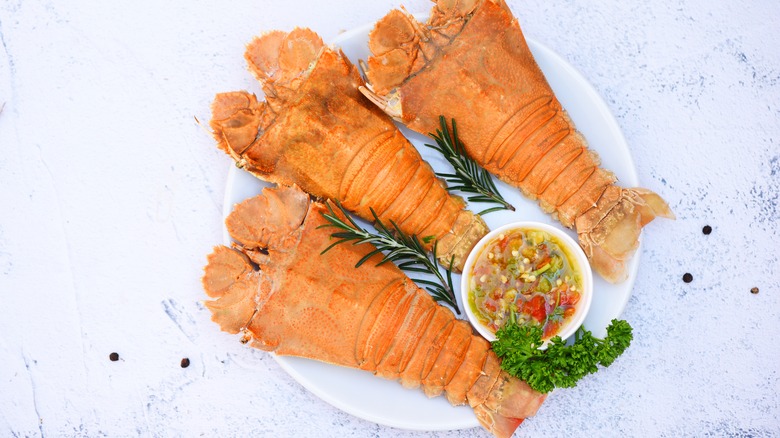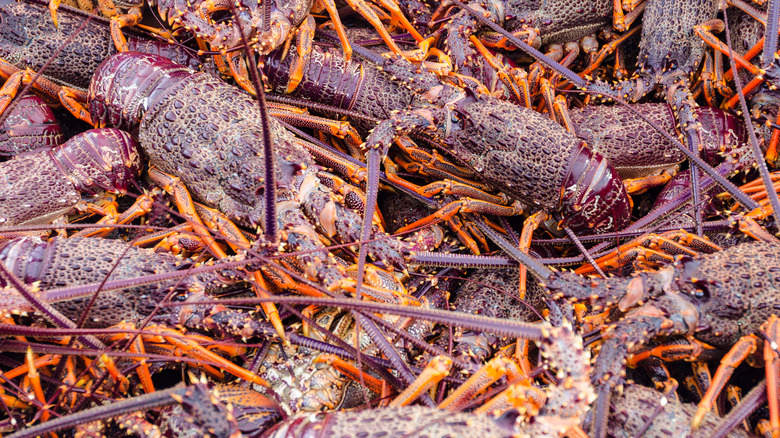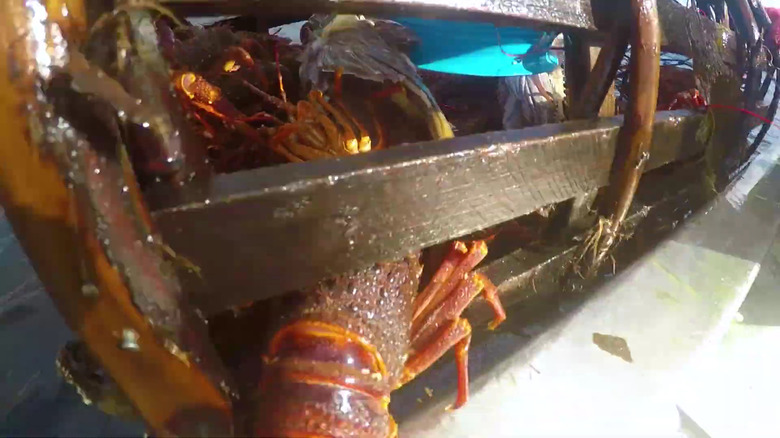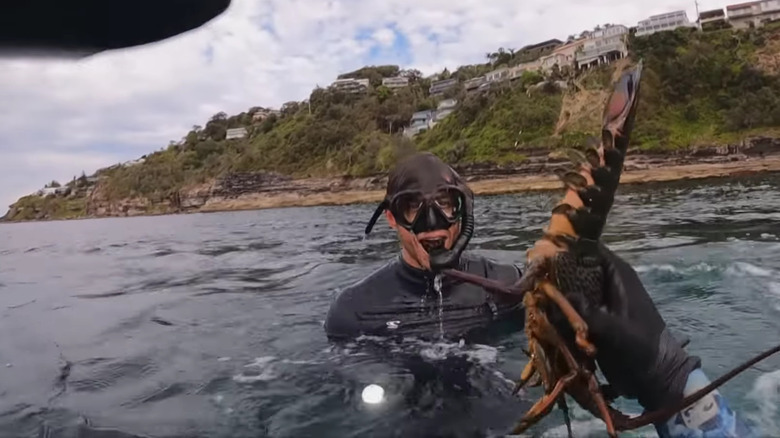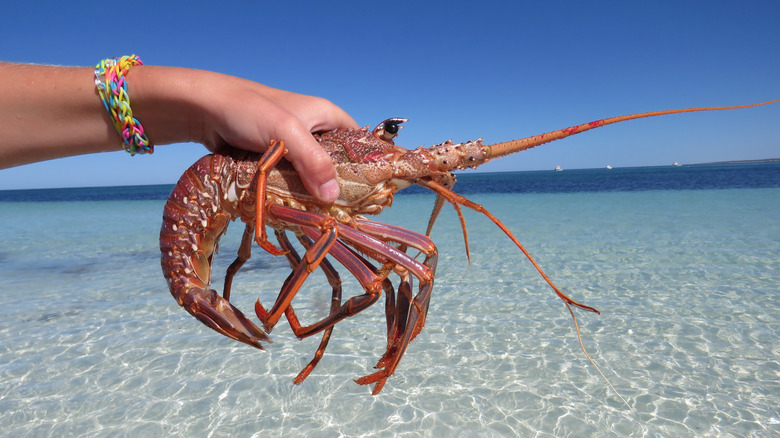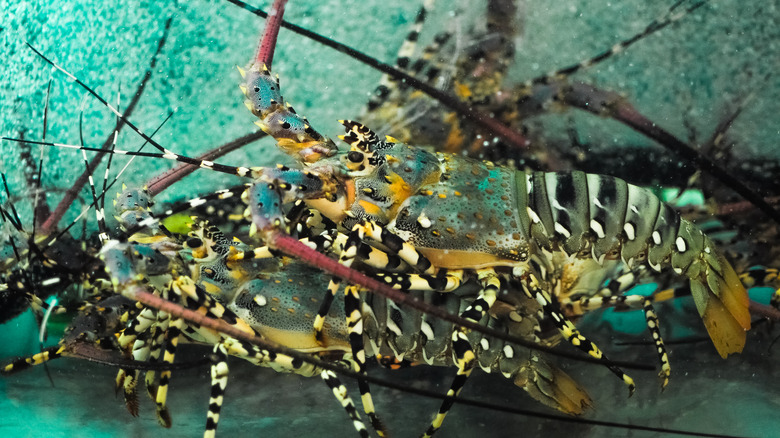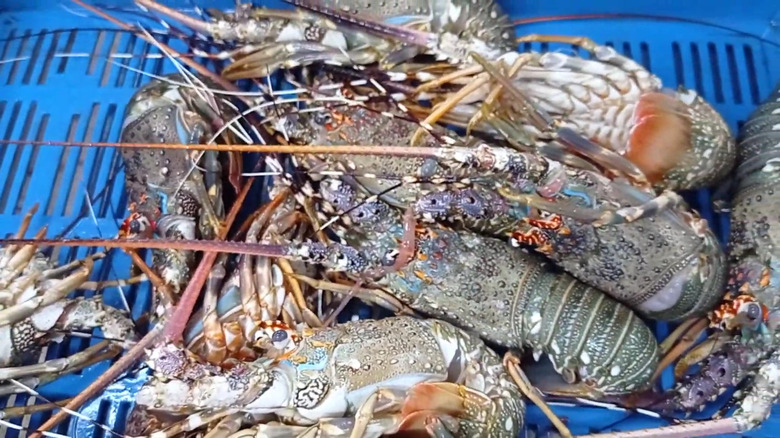The Ultimate Guide To Lobster Varieties
Lobsters have been part of the American diet for centuries, per History. The Indigenous populations ate them well before European colonizers arrived and made the shellfish a part of their diet as well. Because lobsters were so plentiful and "dirt-cheap" during the colonial era, they were fed to apprentices, prisoners, slaves, and kids. This ultimately led to lobster becoming an unfashionable dish.
According to Insider, lobster only became a delicacy during the late 19th century, and its status has been solidified ever since. Fortunately, it seems to be in good supply in the United States. In 2019, there were over 200 million pounds of lobster caught or imported to the United States (via Statista). This is thought to be partly due to an incredible boom in U.S. lobster populations (per Quartz).
When we think of lobsters, we tend to think of the large, clawed beasts that are routinely served at Maine lobster bakes. However, there are numerous species and types of lobsters found on the coastlines of countries around the world. Of course, we cannot provide you with information on them all. As such, this guide aims to introduce you to some of the most popular varieties of this fascinating creature, with the goal of celebrating the varied and delicious nature of lobsters.
Maine lobster (Homarus americanus)
Maine lobster, also known as American lobster, is the animal you probably picture when someone says the word "lobster." They are quintessential in their appearance, having a long, segmented body, antennae, and of course two large claws. The University of Michigan notes that Maine lobster is the largest species, with some growing up to weigh around 45 pounds.
From a culinary standpoint, Maine lobster can be split into two categories: hard shell and soft shell. As The National Lobster Hatchery notes, soft-shell Maine lobsters are simply those that have shed their old exoskeleton recently and are waiting for a new one to form. This is a natural process that occurs frequently throughout all lobsters' lives.
While hard-shell and soft-shell lobsters are the same animal, the shedding significantly affects their taste. As reported by Serious Eats, soft-shell lobsters are sweeter, with a more intense flavor than their hard-shell counterparts. They also tend to lean more toward the savory, salty side.
As previously mentioned, some lobster species — including Maine lobster — are seeing significant population increases, a fact thought to be linked to the warming oceans, per Quartz. But despite the high number of Maine lobster present in American coastal zones, environmentalists are still urging fishing rates to drop. This is because lobster fishing off the eastern coast is seriously harming endangered North Atlantic right whale populations, as these whales frequently get stuck in the fishing lines (via The New York Times).
California spiny lobster (Panulirus interruptus)
The California spiny lobster is another lobster found on American coastlines, albeit on the west coast as opposed to the east. According to California Sea Grant, these lobsters are smaller than Maine lobsters and usually weigh about 2 pounds, although they can reach as much as 26. They do not have pincers or claws, meaning there is no pincer meat to be enjoyed. However, as noted in Vice, this may be the reason the California spiny lobster is so appealing to the Chinese market.
The massive demand from China and the exportation of California spiny lobsters to the country — around 95% of the annual catch — has led to rising costs of this shellfish. This has led to many Americans opting for other, more affordable varieties. This is a great shame given the fact that they are both local to America's west coast and taste incredible. Speaking to Vice, Hank Parfitt, a diver who hunts California spiny lobster, explained how their unique taste makes them superior to Maine lobster. "I did a taste test with friends one time and the California ones won out," he said. "The first bite is slightly chewy. The second one is the most profound — it has a creamy and extremely nutty flavor."
European lobster (Homarus gammarus)
The European lobster is, according to the Centre for Agriculture and Bioscience International, a commercially important species of lobster found in European seas from Norway to Turkey. While appearing strikingly similar to the Maine lobster, the European has fared significantly worse in recent years. Nature reports that the population of European lobster has dropped by a staggering 92% in Norway's coastal waters over the past 100 years. These population drops have been seen in other European countries as well, with the Marine Conservation Society decreeing that European lobster caught off the coast of Scotland can no longer be deemed sustainable due to falling stock, per The Times.
The European lobster is desirable from a gastronomic standpoint because of its firm meat, which, as Miele notes, is extremely flavorful. Publications, such as Great British Chefs, even go as far as to state that European lobster is superior to Maine lobster, although personal preference will surely play a part when choosing one over the other.
Florida spiny lobster (Panulirus argus)
Another lobster found in American waters is the Florida spiny lobster, otherwise known as the Caribbean spiny lobster. As with other spiny lobsters, those in Florida lack large claws, per National Oceanic and Atmospheric Administration Fisheries. So, instead of being valued for pincer meat, these lobsters are prized for their tail meat.
Despite the 2021 landings of Florida spiny lobster reaching over 4.5 million pounds for ships fishing in the South Atlantic and the Gulf of Mexico alone, it is still seen as a sustainable option. This is because population stocks have remained stable or high in recent years, which may be thanks to the number of controls put in place to protect this species from overfishing.
While the Florida spiny lobster may not be the most famous of all lobsters, there is still a passionate discussion on how they should be cooked. According to the Tampa Bay Times, they should never be boiled or steamed, but rather grilled. Florida restauranter Frank Chivas explains, "You have got to grill them. There is no other way [...] I like to cut them in half, then put the meat side down first. You let them cook for a few minutes, then flip them over and add a little grouper stuffing."
European spiny lobster (Palinurus elephas)
The European spiny lobster is a small lobster that can be found in both the Mediterranean, on the coast of Portugal, and around Great Britain and Ireland, per The Marine Life Information Network. As with the European lobster, the European spiny lobster has suffered from dropping population stocks around various European coastlines. The species has even seen localized extinctions in some areas.
This has spurred attempts to discover a means of replenishing stocks. One method that has gained interest recently is breeding the lobsters before releasing them into the wild. As reported by The Guardian, recent developments at a Corsican aquaculture research center seem promising, although questions still abound concerning the genetic risk of interbreeding between wild European spiny lobster and their farmed counterparts.
Other, less artificial means of protecting European spiny lobster stocks have been enforced in Cornwall, England. Here, the minimum landing size has been increased from 95 millimeters to 110 millimeters, per Fish Focus. Chris Ranford, CEO of the Cornish Fish Producers Organization, explained why this measure was put in place. "This is an ambitious step," he said, "but sustainability is a fundamental principle of our industry and our members want to put protective measures in place now, so they can safeguard the stock and continue to benefit from the crawfish fishery in the future."
Slipper Lobster (Scyllaridae)
The term slipper lobster encompasses a whole subset of lobster, including around 90 separate species, as per Hayati Journal of Biosciences. While unique in its appearance, the lobster's body and tail is still covered with a segmented carapace. However, as noted in "The Biology and Fisheries of the Slipper Lobster," they lack large claws and have uncharacteristically wide, flat bodies and heads. Slipper lobsters can be found in warm parts of the oceans and are regularly caught on both the east and west coasts of Australia (via New South Wales Government).
In Israel, slipper lobsters are a much sought-after delicacy, despite being endangered, Haaretz reports. Chef Eyal Lavi explains why the slipper lobster is still seen on menus despite its vulnerability. "Many chefs are unaware of ecological issues," he said. "Slipper lobsters attract an audience, which is more important for a restaurant than nature preservation." The reason why slipper lobsters gain such attention in culinary settings? The animal's delicate, almost translucent flesh, has a markedly sweet flavor, per Sea Port.
New Zealand rock lobster (Jasus edwardsii)
The New Zealand rock lobster, also known as the New Zealand cray or crayfish, has been a key part of diets for those on the archipelago ever since it was first settled by Polynesians during the 12th and 13th centuries A.D., per New Zealand History. They have remained a popular food source ever since, with prime export markets including America and Asia, as reported by Oceana. Due to widespread overfishing in the past, stocks of this highly desirable lobster are now protected using a quota system that has proven remarkably effective.
New Zealand Foreign Affairs and Trade reported that in the first half of 2021, rock lobster exports to China alone accounted for $157 million. One of the main reasons the New Zealand rock lobster has become so widely adored is thanks to its tender, sweet tail meat, as noted by Chatham Island Food Company.
St. Paul rock lobster (Jasus paulensis)
Found sporadically throughout the Southern Ocean, the St. Paul rock lobster is caught in some of the most isolated fishing grounds, according to Two Oceans Aquarium. Perhaps the most famous habitat of this lobster is the coast surrounding Tristan da Cunha, one of the most remote, inhabited archipelagos in the world (via Britannica). Two Oceans Aquarium reports that, until recently, it was thought that the lobsters found around Tristan da Cunha were genetically different from the St. Paul rock lobsters found elsewhere, although that hypothesis has now been disproved.
The archipelago's annual catch of around 400 tons is predominantly exported to the United States, Japan, and Britain, although exports to the European Union have also begun, per the Marine Stewardship Council. Speaking to Tristan da Cunha Fishing News, Andrew James, managing director of a fishing company on the archipelago, discussed why the lobster is so popular. "These are the most exceptional lobsters in every sense and while we could easily supply the entire annual harvest to our current markets, it has long been our ambition to offer our product to the European market," he said. "Now that we are finally here, we hope the market appreciates the lobsters' unique provenance and MSC-certification alongside their superior flavor."
Eastern rock lobster (Sagmariasus verreauxi)
With over 20,000 miles of coastline (via the Australian Government), it is no surprise that Australia is home to several species of lobster. Among these is the eastern rock lobster. According to the Australian Museum, the eastern rock lobster is the largest spiny lobster in the world, with some specimens weighing around 33 pounds. The impressive size these lobsters can reach has made them a favorite of both the Australian and Asian markets.
Per Delicious, the eastern rock lobster is known for packing a sweet flavor complete with a satisfying hit of umami. The publication also reports that noted chefs, such as Thomas Keller, have named this specific species as the best lobster in the world. Despite these highly desirable traits and the popularity of the shellfish, Fisheries Research and Development Corporation defined the eastern rock lobster as sustainable in the 2020 edition of its biennial report. This is thought to be due to management initiatives, such as total allowable catch amounts, which have seen the stock rebound from its lowest point in the 1990s.
Western rock lobster (Panulirus cygnus)
On the west coast of Australia, the most prominent type of lobster is the western rock lobster. Again, this spiny lobster lacks large claws and two antennae that sweep back over its body. The West Australian notes that western rock lobster is a delicacy enjoyed along the western Australia coastline, with signature dishes, such as lobster rolls, lobster mornay, and grilled lobster with garlic butter being served from Perth to Belmont and beyond.
It is not just Australians that have acquired a taste for western rock lobster either. Per Reuters, during the 2018 and 2019 seasons, China purchased a massive 94% of all Australia's rock lobster exports. However, lobster exports to China in recent times have collapsed amid political tensions between the two countries, yet demand remains high. As The South China Morning Post revealed, in order to meet that demand, Australian western rock lobsters are being smuggled into China via Hong Kong.
Speaking to SBS News, Matt Rutter, the CEO of a fishing co-operative, explained why the lobsters are so desirable. "These Australian lobsters are considered the pinnacle of lobsters worldwide," he said. "They are highly sought after worldwide for their color, for the firmness of the flesh as well as taste. And as they don't have claws, there's a much higher meat component compared with the U.S. lobster."
Ornate rock lobster (Panulirus ornatus)
According to the Australian Journal of Freshwater Research, ornate rock lobster is a species that migrates between the southern shores of the Gulf of Papua New Guinea and the northern Australian coastline around the Torres Strait. They are known for their beautiful carapaces, which are patterned with colored stripes and spots, as well as being blue-green in color, per The Fish Site.
As Smithsonian Magazine reports, attempts have been made to breed rock lobsters from eggs, a feat that had previously never been achieved commercially. However, after a breakthrough at a breeding site in Tasmania in 2017, a company called Ornatas began breeding ornate rock lobsters in Queensland with the goal of relieving pressure on the wild population. The process of growing the lobsters through their various larval stages is a difficult one, as reported by ABC News, however, Ornatas hopes to provide a significant amount of ornate lobster every year. These will most likely be exported to traditional markets such as China where the beautiful carapaces and sweet, firm flesh make the lobster perfectly suited for being the centerpiece of sashimi banquets (via The Fish Site).
Scalloped spiny lobster (Panulirus homarus)
The scalloped spiny lobster is green-brown with small flecks of white covering its carapace (via The Fish Site). The lobster is found from the eastern coast of South Africa, up to Somalia, and along the coastlines of Japan and Australia, per the Journal of Crustacean Biology. This, when coupled with the fact that scalloped spiny lobsters are well-suited to aquaculture (via The Fish Site) would suggest to some that they could become a widely farmed and consumed species of the shellfish.
However, farming practices frequently result in high mortality rates for the lobsters, especially when they are in the larval stage. Yet, in some countries like Indonesia — more specifically Lombok — the scalloped spiny lobsters are farmed using techniques that limit the mortality rate. What's more, The Fish Site notes that using these farming techniques can result in the lobster being transformed from baby to a commercially-viable selling size in around nine months. This indicates that the future source of scalloped spiny lobsters will most likely be aquaculture farms.
